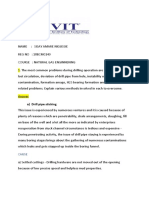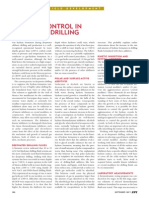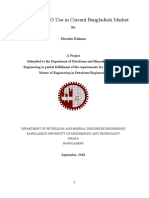100%(1)100% found this document useful (1 vote)
19 viewsSAFYUNA
SAFYUNA
Uploaded by
John MaluguThe document discusses tight gas reservoirs, which are natural gas reservoirs trapped in rock with extremely low permeability, typically limestone or sandstone. Tight gas reservoirs require hydraulic fracturing or horizontal drilling to produce gas at economic rates due to their low permeability and porosity. Logging is used to identify the location, lithology, fractures, permeability and porosity of tight reservoirs. Hydraulic fracturing and horizontal drilling are common production methods used as they increase permeability and contact with the gas-bearing formation. Challenges of producing from tight reservoirs include low permeability, complex geology, water management and high costs.
Copyright:
© All Rights Reserved
Available Formats
Download as PPTX, PDF, TXT or read online from Scribd
SAFYUNA
SAFYUNA
Uploaded by
John Malugu100%(1)100% found this document useful (1 vote)
19 views14 pagesThe document discusses tight gas reservoirs, which are natural gas reservoirs trapped in rock with extremely low permeability, typically limestone or sandstone. Tight gas reservoirs require hydraulic fracturing or horizontal drilling to produce gas at economic rates due to their low permeability and porosity. Logging is used to identify the location, lithology, fractures, permeability and porosity of tight reservoirs. Hydraulic fracturing and horizontal drilling are common production methods used as they increase permeability and contact with the gas-bearing formation. Challenges of producing from tight reservoirs include low permeability, complex geology, water management and high costs.
Copyright
© © All Rights Reserved
Available Formats
PPTX, PDF, TXT or read online from Scribd
Share this document
Did you find this document useful?
Is this content inappropriate?
The document discusses tight gas reservoirs, which are natural gas reservoirs trapped in rock with extremely low permeability, typically limestone or sandstone. Tight gas reservoirs require hydraulic fracturing or horizontal drilling to produce gas at economic rates due to their low permeability and porosity. Logging is used to identify the location, lithology, fractures, permeability and porosity of tight reservoirs. Hydraulic fracturing and horizontal drilling are common production methods used as they increase permeability and contact with the gas-bearing formation. Challenges of producing from tight reservoirs include low permeability, complex geology, water management and high costs.
Copyright:
© All Rights Reserved
Available Formats
Download as PPTX, PDF, TXT or read online from Scribd
Download as pptx, pdf, or txt
100%(1)100% found this document useful (1 vote)
19 views14 pagesSAFYUNA
SAFYUNA
Uploaded by
John MaluguThe document discusses tight gas reservoirs, which are natural gas reservoirs trapped in rock with extremely low permeability, typically limestone or sandstone. Tight gas reservoirs require hydraulic fracturing or horizontal drilling to produce gas at economic rates due to their low permeability and porosity. Logging is used to identify the location, lithology, fractures, permeability and porosity of tight reservoirs. Hydraulic fracturing and horizontal drilling are common production methods used as they increase permeability and contact with the gas-bearing formation. Challenges of producing from tight reservoirs include low permeability, complex geology, water management and high costs.
Copyright:
© All Rights Reserved
Available Formats
Download as PPTX, PDF, TXT or read online from Scribd
Download as pptx, pdf, or txt
You are on page 1of 14
TIGHT GAS RESERVOIRS
What is tight gas reservoir?
Tight gas is natural gas trapped within a rock with extremely low permeability typically
limestone or sandstone.
This is not to be confused with shale gas, which is natural gas trapped within shale
formations. Tight gas is considered to be an unconventional source of natural gas because it
requires significant hydraulic fracturing which is a much more extensive process to access the
gas.
This is because the low permeability of the rock (meaning the pores within the stone are poorly
connected), makes it difficult for the gas to travel through them.
So the definition of a tight gas reservoir is one in which the expected value of permeability to
gas flow would be less than 0.1 md.
How tight gas reservoir is formed
Tight gas reservoirs are formed when natural gas accumulates in rocks with
low permeability, making it challenge for the gas to flow freely.
Overtime the organic materials decompose and transform into hydrocarbons
which then migrate and get trapped into the low permeable rock
i.
Characteristics of tight gas reservoir.
Tight gas reservoir characterized with low porosity and permeability, small drainage radius and require significant
well stimulation
ii. Hydraulic fracture treatment or the use of horizontal or multi-lateral wells to produce at economic rates.
iii. Tight reservoirs are characterized by large pressure gradient across reservoir, often layered and complex and high
transient decline rate.
iv. Typical lithology of tight reservoirs are sandstone/siltstone and rarely carbonate with permeability as low as
(<0.1md)
v. Tight gas reservoirs are generally gas saturated with little or no free water
Logging in tight gas reservoir
Logging is the important process in the petroleum industry.
This process enable to find hydrocarbon in the reservoir and find lithology below the earth surface
Factors identified by logging in tight reservoir
1. Location of the tight reservoir
2. Lithology
3. Natural fracture
4. Permeability
5. Porosity
6. tightness
Reservoir consideration
Normally, a tight gas reservoir can be described as a layered system. In a clastic depositional
system, the layers are composed of;
Sandstone
Siltstone
Mudstone
Shale
In non clastic systems, layers are composed of;
Limestone
Dolomite
Possibly halite or anhydrite
Methods used to produce gas
from tight gas reservoir
Hydraulic fracturing
Hydraulic fracturing is the most common mechanism to create channels( highly conductive path)
by breaking the low permeability rock to increase well productivity.
It involves injection of fluid at high pressure into the reservoir which enable creating fractures
into the rock and helps increasing permeability of the reservoir.
Hence allowing gas flow more easily and maximize gas recovery.
Horizontal drilling
This method involves drilling wells horizontally through the low permeability rock formation
which exposes the wellbore to a larger section of the reservoir and thus increasing contact with
gas bearing rock.
By horizontal drilling enhance the overall productivity of the well compared to the traditional
vertical drilling, also improves the economic viability of extracting gas from the tight formation.
Challenges in tight gas reservoir production
Low permeability: as the tight gas formation have low permeability hence
making difficult for the gas to flow easily unless advanced technology like
hydraulic fracturing is applied.
Complex geology: tight gas reservoirs often have complex geological
structures, which making accurate reservoir characterization and well
placement challenging.
Water management: hydraulic fracturing as the method of producing gas in
tight reservoir involves significant water usage thus managing water
resources, treatment and disposal of produced water are crucial aspect with
environmental and logistical challenges
Costs: the extraction methods of gas in tight gas reservoir are much expensive
in terms of initial investment and operational costs.
THE END
You might also like
- Tight Gas ppt2Document14 pagesTight Gas ppt2Malugu JohnNo ratings yet
- Tight Gas ppt3Document13 pagesTight Gas ppt3Malugu JohnNo ratings yet
- ConvectionalDocument11 pagesConvectionalMalugu JohnNo ratings yet
- Tight GasDocument24 pagesTight GasMalugu JohnNo ratings yet
- T Udom 2020 09398Document26 pagesT Udom 2020 09398Malugu JohnNo ratings yet
- Taibi ZakariaDocument5 pagesTaibi ZakariaZakaria TaibiNo ratings yet
- GREDocument38 pagesGREShani KanwalNo ratings yet
- Aman Ullah Roll No O1 Presentation Topic Tight Reservior and Hydraulic FracturingDocument21 pagesAman Ullah Roll No O1 Presentation Topic Tight Reservior and Hydraulic FracturingAman UllahNo ratings yet
- Non-Conventional Gas Resources. Coalbed Methane, Tight Gas, Shale GasDocument3 pagesNon-Conventional Gas Resources. Coalbed Methane, Tight Gas, Shale GasMukhtarov PgNo ratings yet
- Notes 6Document20 pagesNotes 6Chini ChineeNo ratings yet
- ReservoirDocument14 pagesReservoirMiko Paulo TiotangcoNo ratings yet
- 17A. Shale GasDocument8 pages17A. Shale GasAyush BhadauriaNo ratings yet
- Evaluation of Tight Gas: Law, 2002 Shanley, 2004 Ma Et Al., 2011Document2 pagesEvaluation of Tight Gas: Law, 2002 Shanley, 2004 Ma Et Al., 2011Hammad AhmadNo ratings yet
- Cementing in Shallowwater FlowsDocument9 pagesCementing in Shallowwater FlowsE SchonNo ratings yet
- CBM Vs ShaleDocument2 pagesCBM Vs ShaleKarlina DewiNo ratings yet
- Underground Natural Gas StorageDocument5 pagesUnderground Natural Gas StorageTHE TERMINATORNo ratings yet
- Drilling and Completions SandstoneDocument71 pagesDrilling and Completions SandstoneidownloadbooksforstuNo ratings yet
- Overview of Rocks and Petroleum Reservoir (LAB)Document62 pagesOverview of Rocks and Petroleum Reservoir (LAB)Ketone PropanonNo ratings yet
- TIGHT ReservoirDocument25 pagesTIGHT ReservoirMalugu JohnNo ratings yet
- Correct Da FDocument26 pagesCorrect Da FSisay AmareNo ratings yet
- Mineral Processing 2 L10Document24 pagesMineral Processing 2 L10ahmed kishkNo ratings yet
- Hydraulic FracturingDocument6 pagesHydraulic Fracturingner68100% (1)
- Notes 6 240318 202145Document20 pagesNotes 6 240318 202145Chini ChineeNo ratings yet
- Cement-Slurry Design To Prevent Destabilization of Hydrates in Deepwater EnvironmentDocument5 pagesCement-Slurry Design To Prevent Destabilization of Hydrates in Deepwater EnvironmentPAOLA ANDREA DUARTE PRADANo ratings yet
- 104 273 1 PBDocument5 pages104 273 1 PBYudiansyah Arya DinantaNo ratings yet
- Reservoir Rocks ModificationDocument15 pagesReservoir Rocks ModificationSiwan AbdullahNo ratings yet
- UNIT I CorrectedDocument37 pagesUNIT I CorrectedHameed Bin AhmadNo ratings yet
- Petroleum and Natural Gas Engineering: DepartmentDocument5 pagesPetroleum and Natural Gas Engineering: DepartmentNimra ImranNo ratings yet
- Pet Geo 1Document5 pagesPet Geo 1api-347509160No ratings yet
- Tight Gas Sands 2008Document1 pageTight Gas Sands 2008song LiNo ratings yet
- Tailings DisposalDocument22 pagesTailings Disposalm.samuelworldNo ratings yet
- Lecture 1 (AIU)Document31 pagesLecture 1 (AIU)Ahmd SaberNo ratings yet
- 1 Introduction To Reservoir Rock PropertiesDocument20 pages1 Introduction To Reservoir Rock PropertiesAram RafiqNo ratings yet
- Spe 24605 PaDocument4 pagesSpe 24605 PaFernando Montes de OcaNo ratings yet
- Tigth GasDocument21 pagesTigth GasRoxana FunieruNo ratings yet
- Assign AnsDocument3 pagesAssign Anslovely petsNo ratings yet
- ResearchDocument2 pagesResearchhuntsman3518No ratings yet
- Horizontal Drilling Shale GasDocument7 pagesHorizontal Drilling Shale GasSam BamNo ratings yet
- Types FDFDocument2 pagesTypes FDFaymen telliNo ratings yet
- Auras M. (2008) - Poultices and Mortars For Salt Contaminated Masonry and Stone Objects - SWBSSDocument21 pagesAuras M. (2008) - Poultices and Mortars For Salt Contaminated Masonry and Stone Objects - SWBSSEleonora CigognettiNo ratings yet
- What Is Fracking?: Hydraulic FracturingDocument7 pagesWhat Is Fracking?: Hydraulic FracturingAnurag RoyNo ratings yet
- Mud RheologyDocument12 pagesMud RheologyNwaokorie IkechiNo ratings yet
- SPE-0899-0024-JPT Shallow GasDocument2 pagesSPE-0899-0024-JPT Shallow Gasfaboq93No ratings yet
- Fundamentals of Basic Reservoir Engineering 2010Document293 pagesFundamentals of Basic Reservoir Engineering 2010jollyrex92% (12)
- 2.0 ExplorationDocument9 pages2.0 ExplorationLionelAndersCostaNo ratings yet
- China University of PetroleumDocument13 pagesChina University of PetroleumMIKIAS麦克No ratings yet
- PT GeolDocument88 pagesPT GeolThaw ZinNo ratings yet
- Chap 2 - Introduction To Oil Gas ExplorationDocument36 pagesChap 2 - Introduction To Oil Gas ExplorationOnniey 1201No ratings yet
- Soal Internal Comp SmartcompDocument1 pageSoal Internal Comp SmartcompFahmi FirmansahNo ratings yet
- SPE-185424-MS Unconventional Hydrocarbons: Gas Hydrates - Drilling Challenges and Suitable TechnologyDocument14 pagesSPE-185424-MS Unconventional Hydrocarbons: Gas Hydrates - Drilling Challenges and Suitable TechnologyJackyNo ratings yet
- Carbonate Sequence StratigraphyDocument25 pagesCarbonate Sequence StratigraphyM Joko Tri PrasetyoNo ratings yet
- Hydrate Control in Deepwater Drilling: Field DevelopmentDocument2 pagesHydrate Control in Deepwater Drilling: Field Developmentlulalala8888No ratings yet
- Spe 145409 Submitted ManuscriptDocument14 pagesSpe 145409 Submitted ManuscriptKahfi MontazeriNo ratings yet
- 2surface Mining MethodsDocument13 pages2surface Mining Methodsisithkesara23No ratings yet
- Onge 2Document177 pagesOnge 2pandianvijaybharathiNo ratings yet
- Drilling FluidDocument3 pagesDrilling FluidShamsi MursalliNo ratings yet
- Petroleum TrapsDocument22 pagesPetroleum TrapsAmmara dawoodNo ratings yet
- Scientific American Supplement, No. 508, September 26, 1885From EverandScientific American Supplement, No. 508, September 26, 1885No ratings yet
- Lubricating Oil NewDocument11 pagesLubricating Oil NewJohn MaluguNo ratings yet
- AssnDocument1 pageAssnJohn MaluguNo ratings yet
- MaryamDocument16 pagesMaryamJohn MaluguNo ratings yet
- Price STU 2024Document7 pagesPrice STU 2024John MaluguNo ratings yet
- Assignment 1 2024Document2 pagesAssignment 1 2024John MaluguNo ratings yet
- INDIA - Code of Ethics For Corporate Members-1Document2 pagesINDIA - Code of Ethics For Corporate Members-1John MaluguNo ratings yet
- Lecture 4Document30 pagesLecture 4John MaluguNo ratings yet
- Field Development and Plant Design 2024Document4 pagesField Development and Plant Design 2024John MaluguNo ratings yet
- PE 425 Group No 14Document12 pagesPE 425 Group No 14John MaluguNo ratings yet
- PE 425 NewDocument15 pagesPE 425 NewJohn MaluguNo ratings yet
- Power To Gas Linking Electricity and Gas in A Decarbonising World Insight 39Document17 pagesPower To Gas Linking Electricity and Gas in A Decarbonising World Insight 39Aminos MaNo ratings yet
- Oil and Gas Industry in BruneiDocument28 pagesOil and Gas Industry in BruneiMN Izhharuddin100% (7)
- Emergency Responder Guidance LNG Brochure 20190731Document2 pagesEmergency Responder Guidance LNG Brochure 20190731Ahmed ElbarbaryNo ratings yet
- Gastos No DeduciblesDocument4 pagesGastos No DeduciblesHernando Aguilar cocaNo ratings yet
- Journal of Environmental Chemical EngineeringDocument9 pagesJournal of Environmental Chemical EngineeringEVCNo ratings yet
- Oil & Gas Industry in IndonesiaDocument17 pagesOil & Gas Industry in IndonesiaSuleiman BaruniNo ratings yet
- Curriculum Vitae: Satria Nugraha, S.TDocument1 pageCurriculum Vitae: Satria Nugraha, S.TRasyada HumairaNo ratings yet
- Full ThesisDocument110 pagesFull ThesisfazlulfaisalNo ratings yet
- Geothermal Drilling Problems 1649188331Document10 pagesGeothermal Drilling Problems 1649188331Abdulaziz QasimNo ratings yet
- Infnity Mba LPG GasDocument47 pagesInfnity Mba LPG GasAditya JainNo ratings yet
- Handbook of Pipeline Engineering by ABCM (2024)Document1,700 pagesHandbook of Pipeline Engineering by ABCM (2024)melchorodriguezNo ratings yet
- VN With Isx Natural GasDocument16 pagesVN With Isx Natural GasPeter JoelNo ratings yet
- 2 Energy Resources MCQs (Set-I)Document15 pages2 Energy Resources MCQs (Set-I)WasimNo ratings yet
- Ihza Zaki Safari-ResumeDocument1 pageIhza Zaki Safari-ResumeIhza Zaki Safari 05No ratings yet
- Oil and Gas Snapshot of States Vol 1 Edition 2Document80 pagesOil and Gas Snapshot of States Vol 1 Edition 2punkdragonkingNo ratings yet
- Santej 4Document5 pagesSantej 4Mahendra ShahNo ratings yet
- H2S Gas Scrubber DryDocument2 pagesH2S Gas Scrubber DryKapwell LimitedNo ratings yet
- Assignment On Recent Advances in Drilling Industry (Horizontal Drilling)Document2 pagesAssignment On Recent Advances in Drilling Industry (Horizontal Drilling)Vedanti BardeNo ratings yet
- Recovery of Heavy Oil byDocument16 pagesRecovery of Heavy Oil byAmit Kumar SinghNo ratings yet
- Master Sayed Ahmed Hassan 2022Document64 pagesMaster Sayed Ahmed Hassan 2022Hugo VillardiNo ratings yet
- Tpa LNG 2010 Complete FinalDocument411 pagesTpa LNG 2010 Complete FinalwalidNo ratings yet
- 3A.2 - Reading (Course Book)Document4 pages3A.2 - Reading (Course Book)Trần Quốc Cảnh 12C1No ratings yet
- MAN-4014-00 Gas Program Overview ManualDocument19 pagesMAN-4014-00 Gas Program Overview ManualManual SourceNo ratings yet
- CNG Experience in Delhi - Mr. P.K. Pandey - IGLDocument57 pagesCNG Experience in Delhi - Mr. P.K. Pandey - IGLkeshav bansalNo ratings yet
- PGAS Business Presentation 9M2019Document20 pagesPGAS Business Presentation 9M2019eko handoyoNo ratings yet
- Request-for-Class-New-Construction ABSDocument21 pagesRequest-for-Class-New-Construction ABSjames kNo ratings yet
- Ehouse Presentation R2Document48 pagesEhouse Presentation R2zubkomi87100% (1)
- TBWES Consolidated BrochureDocument36 pagesTBWES Consolidated Brochurevsquare55No ratings yet
- Methyldiethanolamine As A Solvent For Gas DesulfurizationDocument66 pagesMethyldiethanolamine As A Solvent For Gas DesulfurizationAnime MtNo ratings yet
- Sulphur - Magazine Sept-Oct - 2021 - CompressedDocument64 pagesSulphur - Magazine Sept-Oct - 2021 - CompressedGuillaumea Foucault100% (2)



































































































